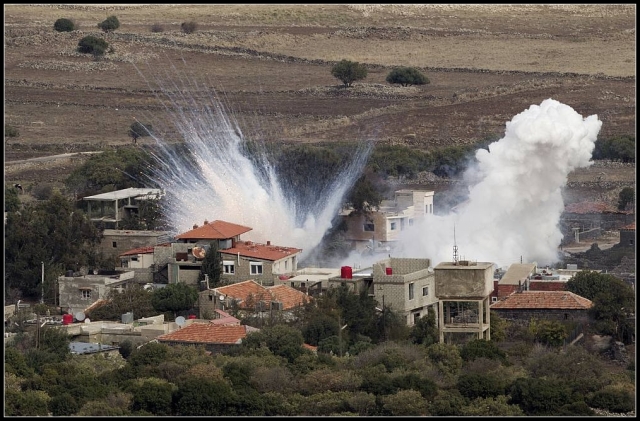Whilst many observers and media sources have been mistaking ZAB-2.5 incendiary submunitions for white phosphorus (WP) munitions, it appears that one incident showcasing limited use of WP has gone largely overlooked. On the 13th of November, Israeli Defence Forces (IDF) Merkava Mark IV tanks engaged “Syrian mobile artillery units”, in response to mortar rounds fired by Syrian government forces impacting near an Israeli military position, according to an IDF spokesman.
One of our readers pointed out the photograph seen above, taken by photographer Ariel Schalit, which appears to show the explosion of a unitary white phosphorus projectile. Unlike cargo projectiles like the M825A1 projectile (described in this piece), unitary (conventional) WP projectiles contain a solid mass of WP and a central bursting charge. They are typically employed with a point detonating fuze, which functions upon contact with the target. The fuze detonates the central burster, dispersing the WP filler. The video below shows the detonation and dispersal pattern of a conventional WP artillery projectile, in this case a US-made 155mm M110A1 shell.
According to observers, the image shows shells fired by the Syrian army exploding in the Syrian village of Bariqa, near the Israeli border. Whilst the IDF spokesman referred to ‘mortar rounds’ landing in Israel, it is unclear whether the ‘mobile artillery’ in question are self-propelled mortars or self-propelled howitzers. Syria is known to operate Soviet/Russian-produced 2S1 Gvozdika (122mm) and 2S3 Akatsiya (152mm) self-propelled howitzers, and is also believed to possess a number of Czech ShM vz.85 PRÁM-S 120mm self-propelled mortars (though this has not been confirmed). The Syrian Army is also known to have fitted some 2A18 (D-30) 122mm howitzers to T-34 tank hulls to form a basic self-propelled artillery piece; it is unknown how many of these are in service. 2S1 systems can be seen in the video below , and 2S3 systems have been identified in material released by the US Department of State (also below).
2S1 self-propelled howitzers near Hama.
 2S3 self-propelled gun-howitzers near Az Zabadani (US Department of State).
2S3 self-propelled gun-howitzers near Az Zabadani (US Department of State).
Each of these self-propelled howitzers have compatible WP projectiles, with some of the possibilities as follows:
122mm: The Soviet/Russian D-4 series WP smoke projectiles, in 122mm, contain approximately 3.6kg of WP in a 499mm long projectile (see below). Chinese Type 54 122mm WP smoke projectiles are similar in nature.
152mm: The D-540, In 152mm (actually 152.4mm), is a 689.7mm projectile which contains approximately 6.6kg of WP. The Chinese equivalent is the Type 66 152mm WP smoke projectile.
120mm mortar: The Russian D-5 120mm WP mortar round is also a conventional WP projectile, and is 592mm long. Yugoslav M64P1, Iranian ‘120 Smoke, WP’, and similar Chinese mortar projectiles are some of the many equivalents that may have been supplied to Syria.
At this stage, the 2S1 and 2S3 systems seem the most likely fit, but nothing can be confirmed. If any of our readers have further images or information which might point to which system and which munitions were used in the attack pictured, please get in touch.
Our thanks to Yoav Geva for the tip on the WP photo. Thanks are also due to Alex Diehl, Yuri Lyamin, and Bjørn Holst Jespersen for their assistance. The 122mm D-4 diagram/image is taken from a US NAVEOD publication (Unclassified). Some information referenced is drawn from Jane’s Ammunition 2009-2010.
Update 19/12/2012: Yoav Geva has sent in this Israeli news video, which shows some towed artillery pieces at the scene of this event. There is no indication if they were involved, but it is of course entirely possible the WP shell projectile was fired from a field artillery piece such as the 2A18 (D-30) 122mm howitzer, known to be in the Syrian inventory.
Also, Bjørn Holst Jespersen sent in the following video (apparently filmed on the 15th of April, this year) which appears to show a WP projectile bursting in Homs.
Both of these videos add important details to the discussion. As yet, we have still seen no evidence of air-delivered WP, however we would very much like to hear from anyone who has.
Remember, all unexploded munitions are dangerous. You can visit RRMA for more information. As always, if you see any UXO, remember the ‘ARMS’ acronym:
•AVOID the area
•RECORD all relevant information from a safe distance
•MARK the area to warn others
•SEEK assistance from the relevant authorities



[…] on December 17, 2012 by N.R. […]
[…] conflict. Update16/12/2012: I have observed what is likely limited use of WP munitions in Syria. More here. Note that many sources are still misidentifying ZAB-2.5 subs (and possibly ZAB series conventional […]
[…] with increasing frequency in the Syrian conflict. Aside from ZAB-2.5 incendiary submunitions, and white phosphorus (WP) projectiles, ZAB-100-105 incendiary free-fall bombs have also been observed within […]